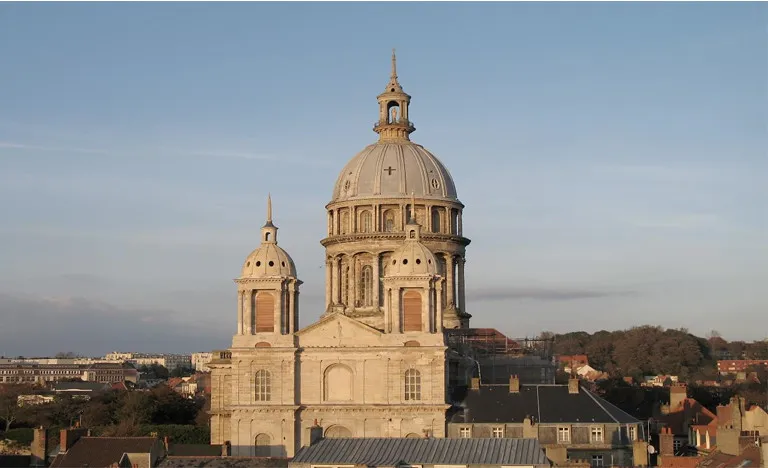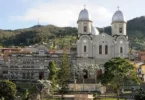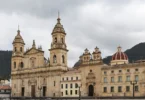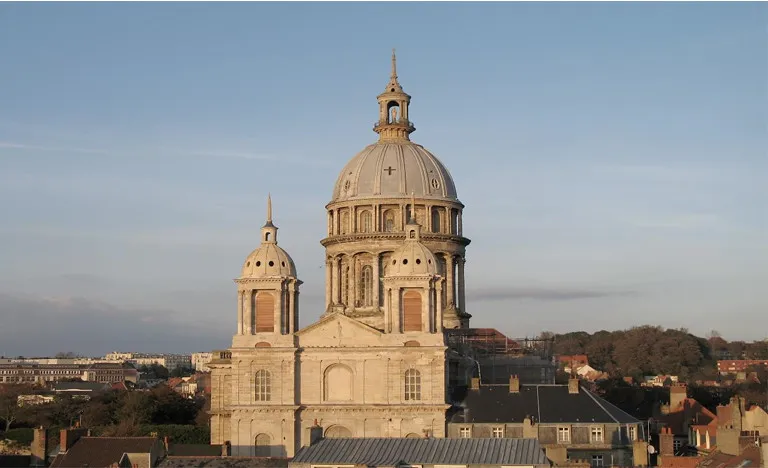
Introduction
The Basilica of Notre-Dame, Boulogne, otherwise the Basilica of Our Lady of the Immaculate Conception (French: Basilique Notre-Dame de Boulogne; Basilique Notre-Dame-de-l’Immaculée-Conception), is a minor basilica located in Boulogne-sur-Mer in the Pas-de-Calais département of northern France. The basilica, a prominent landmark of the city with its 101 metre high dome, was built between 1827 and 1875 on the site of the medieval cathedral of Boulogne: the basilica is still known locally as the “cathedral”, although the present church has never had that status.
The Basilica of Notre-Dame, Boulogne-sur-mer was built in the 19th century on the ruins of the medieval church. The current basilica is actually a double church. A classical church where you first enter and at the end there is an additional chapel under the dome. You can only find this type of layout in Paris: Dome des Invalides, where Napoleon is buried. During the reconstruction of the church, the discovery of the ancient Roman crypt underneath the church led to inspiration for the construction of a giant crypt under the entire surface of the basilica.
In the crypt you will find murals from different eras, including Romanesque and Gothic paintings, with a total surface of approximately 4000 m². The murals from the 19th century contain 160 figurative scenes dedicated to the characters of the church, the old and the new testament, the history of Notre Dame in Boulogne. Sculptures and archaeological finds with lapidary elements from Romanesque, Roman and Gothic art and architecture can be found in the crypt as well.
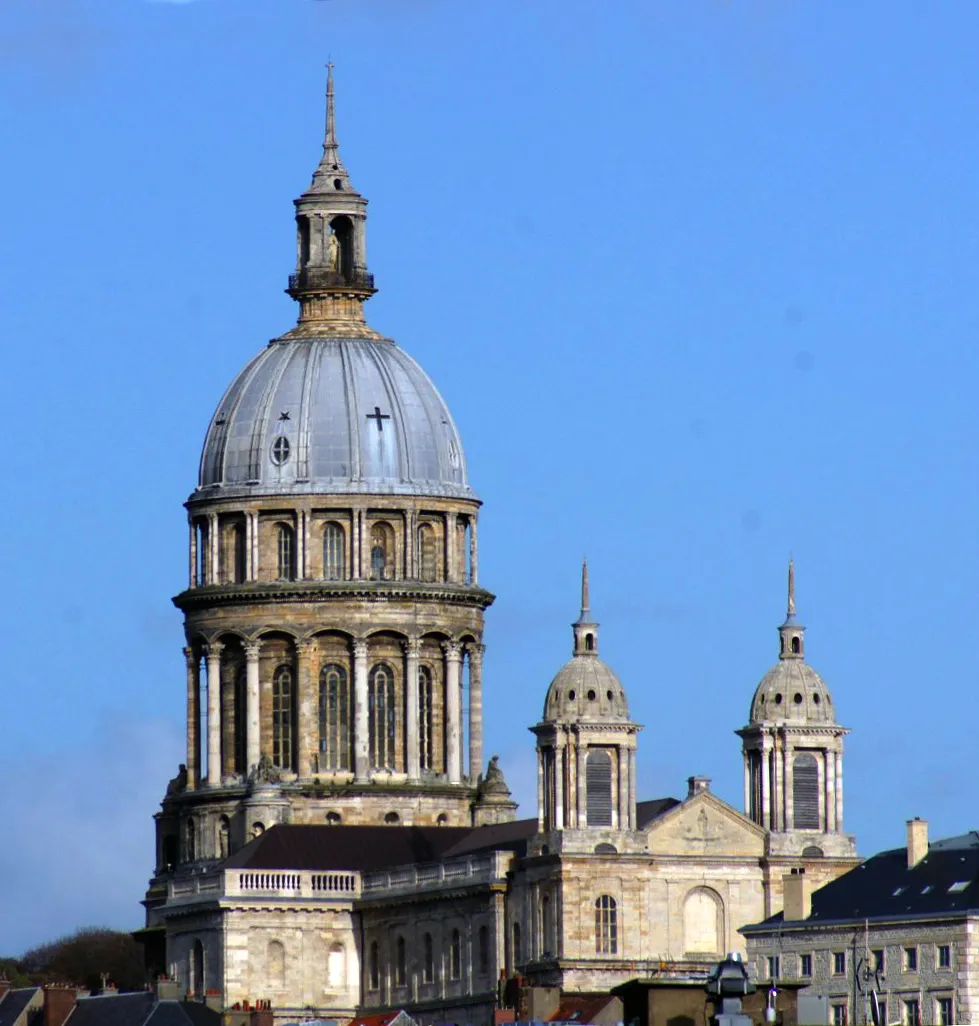
The site of modern Boulogne was occupied by the Romans and was used by the Emperor Claudius as his base for the Roman invasion of Britain. By the 4th century, the town, known as Bononia, was a major port of the empire.
The first Christian building on the site was probably built by the Romans during the 4th or 5th century, on the peak of the hill that forms the modern haute ville.
According to legend, in about 633, while Saint Audomare was bishop of Thérouanne, an unmanned boat carrying a luminous statue of the Virgin Mary was sighted in the estuary at Boulogne. The statue was carried to the church and soon miracles were reported at the site. Between the 13th and 16th century the statue, known as Notre-Dame de la Mer (“Our Lady of the Sea”), became a popular object of pilgrimage, bringing prosperity to the town.
In around 1100 a new church was built on the site and over the next few centuries underwent numerous changes, such as the addition of a choir in the 14th century. In 1308 it was the location of the wedding of Edward II of England to Isabella of France, an event commemorated by a memorial in the crypt.
Notre-Dame was built to a new design inspired by both Classical and Renaissance styles, and bears many similarities to St Paul’s Cathedral. The area beneath the dome was initially designed to form the complete church, but additional funding allowed the expansion to the nave and transept that form a Latin cross. This gives the finished building the unusual internal appearance of being formed by two distinct churches, each of which is equally beautiful.
The tall nave is dominated by its rows of slender Corinthian columns, with unusual features scattered throughout. Haffreingue’s lack of professional training unfortunately gave the building an inherent fragility that led to the collapse of the nave’s arches in 1921. During their reconstruction the whole building was reinforced with concrete, which without doubt allowed it to survive the bombing received by the city during World War II.
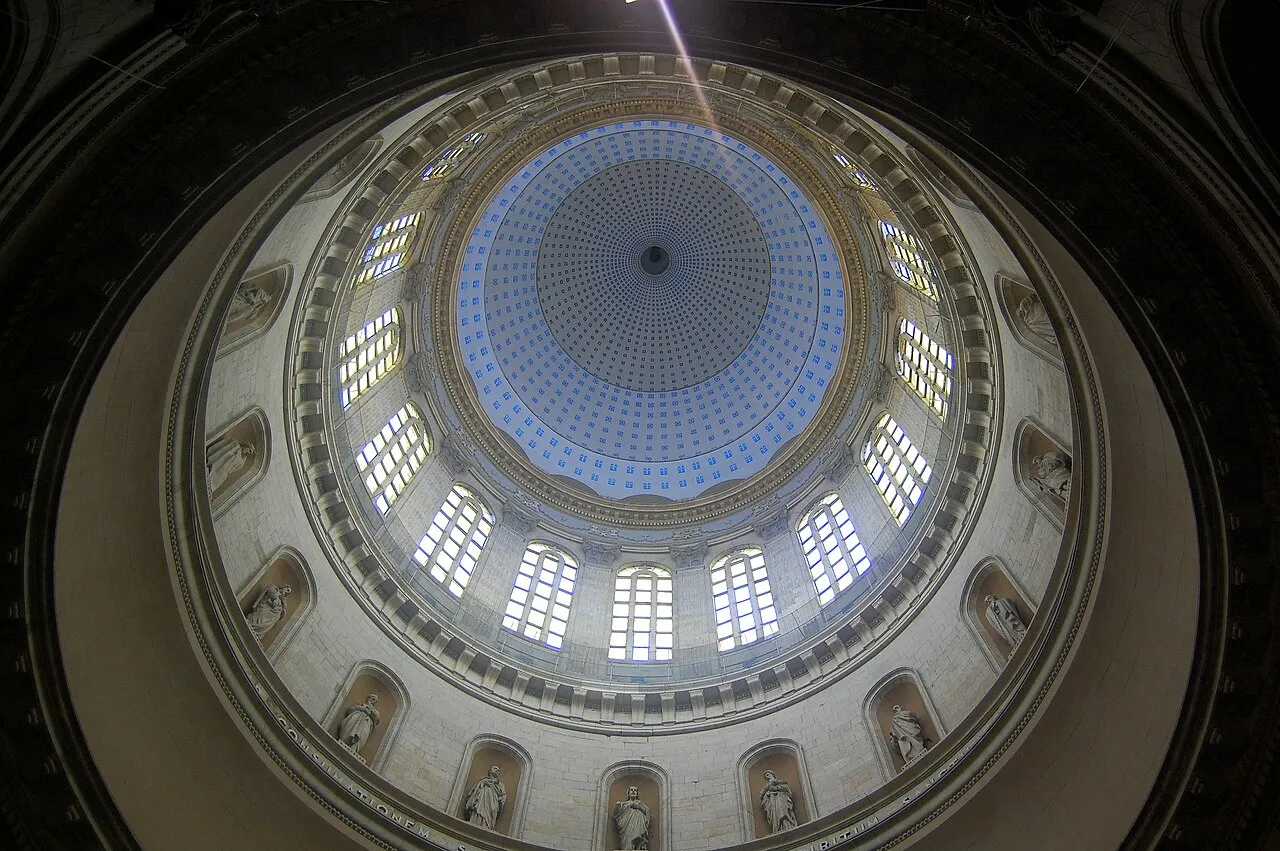
Architectural styles: Neoclassical architecture, Classical architecture, Historicism
Architect: Benoît Haffreingue
Situated in the heart of Paris, the iconic Notre-Dame Cathedral serves as a shining example of architectural genius and the artistic spirit of its era. Combining elements of both Gothic and Romanesque styles, the cathedral has captivated visitors worldwide, drawing them in with its breath taking design and storied past. We’ll guide you through the cathedral’s most striking features and delve into the rich history that defines Notre-Dame de Paris.
Constructed over the course of two centuries, from the 12th to the 14th with modifications made in the 18th century and a major restoration project in the 19th century, Notre-Dame Cathedral represents the progression from Romanesque to Gothic architecture. Its impressive façade is adorned with an array of intricate sculptures, each telling the tale of various biblical figures and events, and showcasing the talent of the artisans involved in its creation. The entrance is framed by three ornate portals – the Portal of the Virgin, the Portal of the Last Judgment, and the Portal of Saint-Anne – each bearing its own distinct narrative and symbolism.
Notre Dame Cathedral Paris Among Notre-Dame’s most noteworthy architectural features are the flying buttresses, a ground breaking innovation from the Gothic period that enabled the construction of taller, more slender buildings. These external supports gracefully stretch from the walls to the ground, distributing the weight of the colossal structure and allowing for the installation of expansive stained-glass windows. The awe-inspiring Rose Windows, considered among the finest examples of Gothic stained-glass craftsmanship, drench the cathedral’s interior in a mesmerizing array of colors and light.
The interior of Notre-Dame is equally majestic, featuring a grand nave, elaborate rib vaults, and towering columns that create a sense of elevated space and height. The choir and high altar, situated at the core of the cathedral, are embellished with intricate carvings and artistic masterworks, inviting visitors to linger and reflect.
Over the centuries, Notre-Dame Cathedral has endured the tests of time, conflict, and a devastating fire in 2019. Yet, its persistence and the ongoing restoration efforts speak to the unwavering spirit of the French people and their dedication to preserving this invaluable cultural gem. As a testament to human creativity and spiritual yearning, the exceptional architecture of Notre-Dame de Paris will continue to fascinate and inspire generations to come.
Boulogne’s Notre-Dame Basilica and Crypt are Fascinating. Boulogne’s Notre-Dame Basilica certainly evokes memories of Invalides and the Panthéon in Paris as well as Saint Peter’s in Rome and Saint Paul’s in London. All of those gave inspiration to its builder here in Boulogne. In truth, the crypt and the altars in the room under the cupola dome captivate the most. The Basilica itself dates from 1866, built after the destruction of the older cathedral during the Revolution. Rebuilding took place between 1827 and 1866. Although repeatedly referred to as a cathedral, this Basilica never regained its “cathedral” status. At 101 meters high, the cupola is quite prominent! The walled part of Boulogne rests on a high point in the city, designed as a protective measure.
Boulogne Cathedral
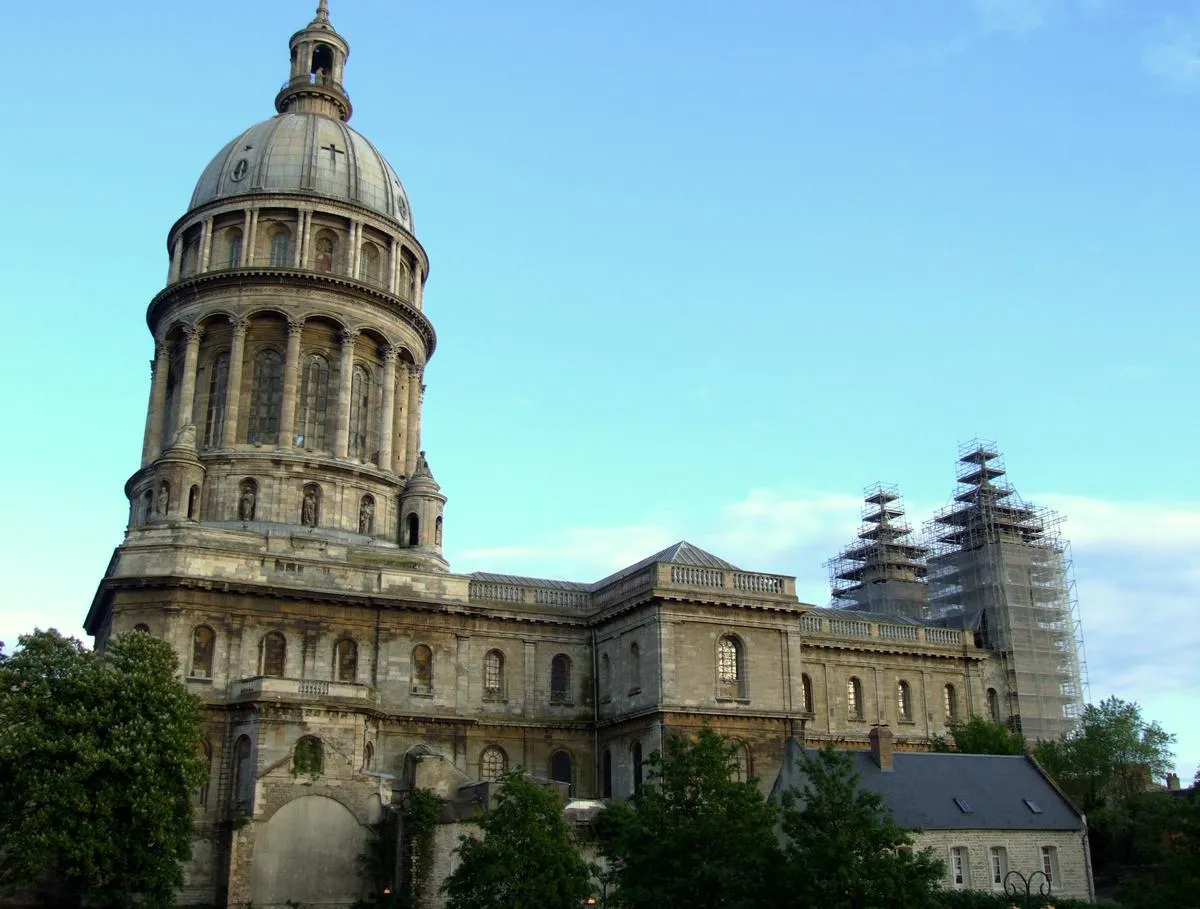
In 1567, on the creation of the Diocese of Boulogne, the church was elevated to be its cathedral, and flourished until the French Revolution, when the Civil Constitution of the Clergy of 1790 brought it under government control. Worship in the cathedral was prohibited: the Convent of the Annonciades (Order of the Annunciation of the Blessed Virgin Mary) became the centre of worship in Boulogne, and after a period as a military warehouse, the cathedral was sold to traders from outside the city. The building was then demolished in stages, and, in 1793, the celebrated miraculous statue of Our Lady of the Sea was burned. Only a small portion of the statue’s hand survived. Of the original cathedral, only the impressive Romanesque crypt from the medieval building survives.
A local priest and self-taught architect, Benoît Haffreingue, vowed to rebuild the destroyed cathedral to restore the honour of Our Lady of the Sea and return the episcopal seat to the city. After a vigorous campaign he was able to gain the support of many, including Victor Hugo and François-René de Chateaubriand, and soon had considerable public opinion behind him.
Construction of his design began in 1827 with the building of the rotunda and continued for nearly fifty years. The dome that now dominates the town was finished in 1854 and its western towers were completed in the 1870s. However, despite the support that Haffreingue’s campaign gathered, the bishop’s seat was not returned to Boulogne and the building thus never regained its status as a cathedral. In 1879 the rebuilt church was declared a minor basilica.
The crypt of Basilique Notre-Dame-de-l'Immaculée-Conception
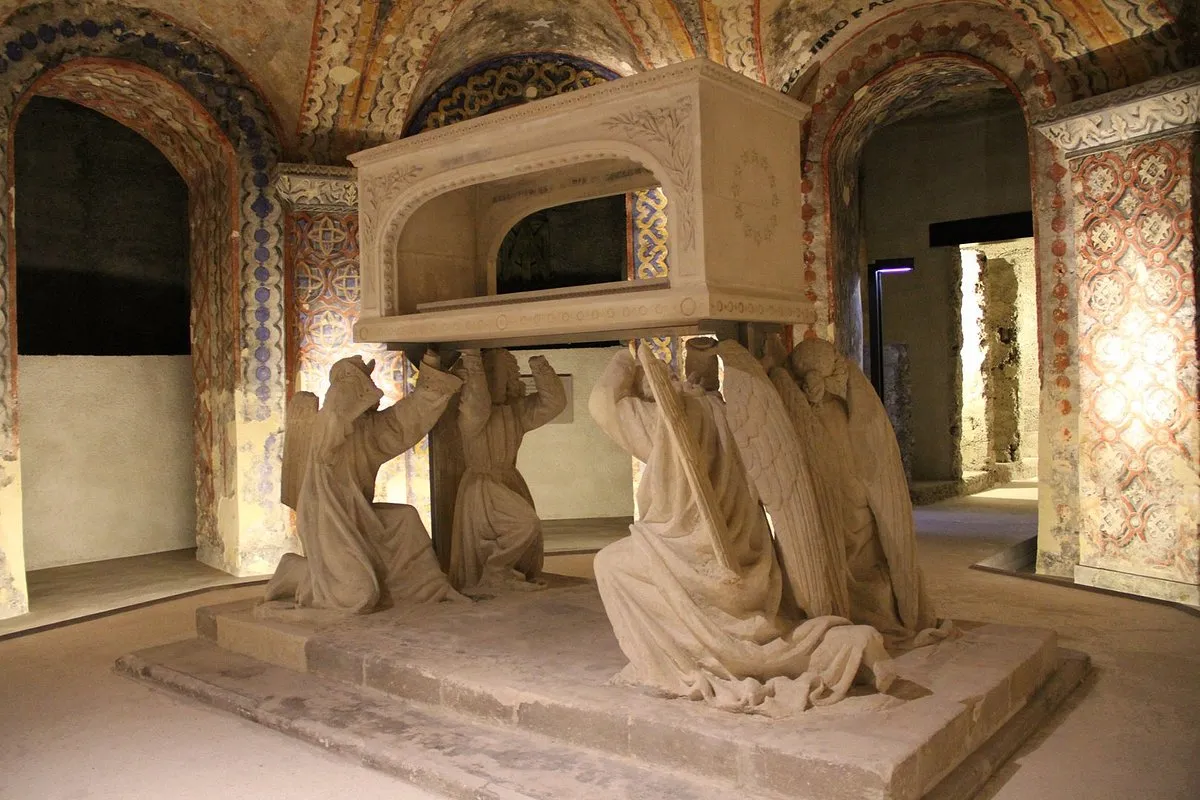
When Haffreingue began work on the new church in 1827, the workmen discovered a crypt that had lain unknown for centuries, having probably been filled in during the 1544 siege of Boulogne by Henry VIII of England. The crypt is 128 metres long in total, and is believed to be the longest in France. Its Romanesque columns date back to the 11th century. With 19th-century masonry accompanying the original medieval work, the many rooms also include the foundations of a Roman temple dedicated to Mars. Cannonballs from the siege of 1544 lie alongside offerings from the site’s many medieval pilgrims. The crypt includes a chapel in which the body of José de San Martín, the South American liberator, was buried between his death in 1850 and its return to Buenos Aires in 1861.
Annual Feast Day
Feast day : February 20
The annual feast day of Basilica of Notre-Dame, Boulogne is celebrated on February 20 each year.
Mass Timing
Church Visiting Hours
- Monday: 07:30 AM – 07:00 PM
- Tuesday: 07:00 AM – 07:00 PM
- Wednesday: 07:00 AM – 07:00 PM
- Thursday: 07:00 AM – 07:00 PM
- Friday: 07:00 AM – 07:00 PM
- Saturday: 07:00 AM – 07:00 PM
- Sunday: 07:30 AM – 07:00 PM
Contact Info
2 Parvis Notre Dame,
62200 Boulogne-sur-Mer,
France.
Phone No.
Accomodations
How to reach the Sanctuary
Airway
The nearest airport to the Church of Basilica of Notre-Dame, Boulogne is Aérodrome de Boulogne-sur-Mer – Alprech Airport which is just 3 min (400.0 m) via Rue de l’Oratoire kilometres away from the basilica.
Railway
The nearest railway to the Church of Basilica of Notre-Dame, Boulogne is Boulogne-sur-Mer which is just 15 min (6.0 km) via D119 kilometres away from the basilica.

